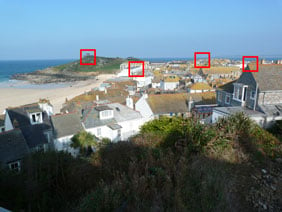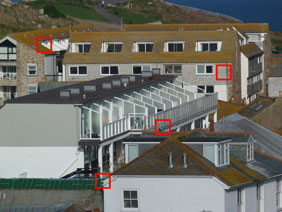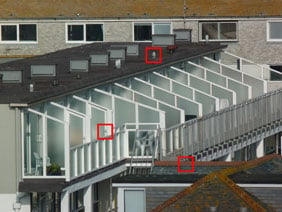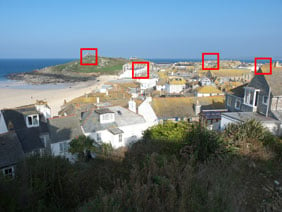Panasonic Lumix DMC-FZ45 / FZ40
-
-
Written by Gordon Laing
Quality
Panasonic Lumix FZ45 / FZ40 vs Lumix FZ100 vs Canon PowerShot SX30 IS Real-life resolution (wide)
Panasonic Lumix FZ45 / FZ40 results : Real-life resolution / Sharpness mid-range / Sharpness tele / High ISO Noise / Vs FZ38 / FZ35
Panasonic Lumix FZ45 / FZ40 | Panasonic Lumix FZ100 | Canon PowerShot SX30 IS | ||
 |  |  | ||
f4, 80 ISO | f4, 100 ISO | f4, 80 ISO | ||
 | 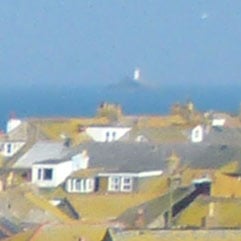 | 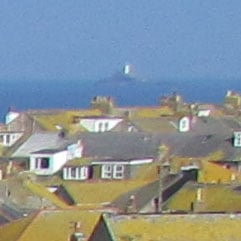 | ||
f4, 80 ISO | f4, 100 ISO | f4, 80 ISO | ||
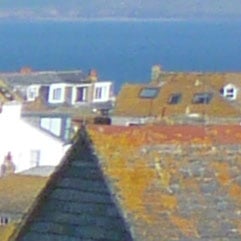 | 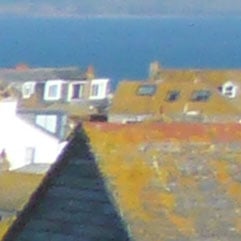 | 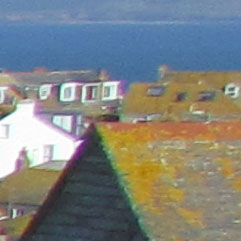 | ||
f4, 80 ISO | f4, 100 ISO | f4, 80 ISO | ||
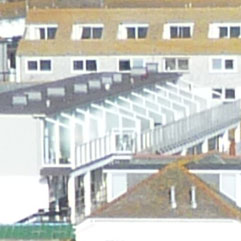 | 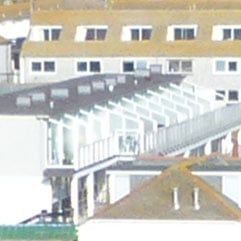 | 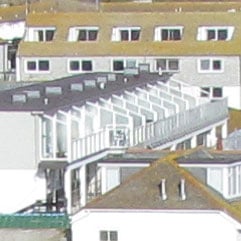 | ||
f4, 80 ISO | f4, 100 ISO | f4, 80 ISO |
Panasonic Lumix DMC-FZ45 / FZ40: JPEG versus RAW (including FZ100 RAW)
| We photographed the scene pictured above using the FZ45 / FZ40’s RAW plus Large Fine JPEG mode, allowing us to directly compare images created from exactly the same data. Below are 100% crops taken from the original JPEG file alongside the RAW version, processed with the supplied Silkypix Developer Studio 3.1 SE; by default, the Unsharp Mask is set to zero in SilkyPIX, which unsurprisingly delivers a very soft result, so here we’ve increased the amount to 100 in order to accentuate fine details. We’ve also included crops taken from the FZ100’s RAW file, processed with the same settings for comparison. Note in the first row of crops, the distant building was in shade when we took our FZ45 / FZ40 sample, but the other areas of the composition weren’t affected.At first glance the in-camera JPEG and processed RAW results from the FZ45 / FZ40 look quite similar with the default settings, but look closely and you’ll spot greater noise speckles on the latter, especially in flat areas of colour like the blue sky. Clearly the FZ45 / FZ40 is applying greater noise reduction to its in-camera JPEGs by default than the standard settings of Silkypix. Which is better is entirely personal: some may like all speckles to be smoothed-out by noise reduction, even at the cost of ultimate detail, while others will prefer a more hands-off approach which leaves some noise behind in an attempt to preserve detail. Of course the important question is whether there is actually any more detail visible on the RAW version, and the answer is very little in this case. But the valuable thing is having access to a wide variety of settings to tweak, along a higher dynamic range to play with, so those who want to get the best from their FZ45 / FZ40 should definitely shoot in RAW and experiment with different settings for the desired result. Moving onto the FZ100 crops, it’s clear they’re also showing more noise speckles than the in-camera JPEG (seen above); it’s certainly revealing to see the FZ100 RAW file suffering from more noise than the FZ45 / FZ40 at the same ISO sensitivity. But while the FZ100 RAW crops below are noisier than those from the FZ45 / FZ40 alongside it, they’re arguably preferable to the overly-smeared results from in-camera JPEGs above. Clearly the FZ100’s CMOS sensor is noisier than the CCD in the FZ45 / FZ40, and Panasonic has attempted to mask this with overly-aggressive noise reduction. But for our money, turning down the noise reduction, whether on in-camera JPEGs or by processing RAW files, produces a better result. Yes there’s much more visible noise, but also lots more detail. We’ll take a closer look at the FZ100’s image quality in our separate review of that camera.  Now let’s look at how the camera performs at longer focal lengths in our mid-range resolution and telephoto resolution test pages before seeing how it compares at higher sensitivities in our High ISO Noise results. |
Panasonic Lumix FZ45 / FZ40 (JPEG) | Panasonic Lumix FZ45 / FZ40 (RAW) | Panasonic Lumix FZ100 (RAW) | ||
 |  | |||
f4, 80 ISO | f4, 80 ISO | f4, 100 ISO | ||
 | 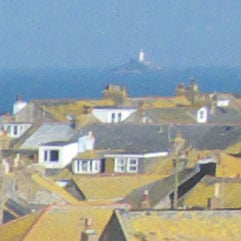 |  | ||
f4, 80 ISO | f4, 80 ISO | f4, 100 ISO | ||
 | 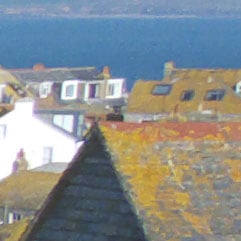 | 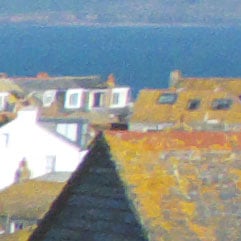 | ||
f4, 80 ISO | f4, 80 ISO | f4, 100 ISO | ||
 | 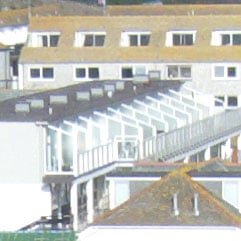 | 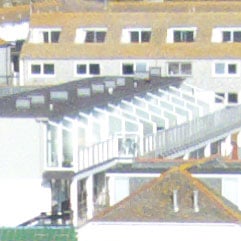 | ||
f4, 80 ISO | f4, 80 ISO | f4, 100 ISO |
Panasonic Lumix FZ45 / FZ40 results : Real-life resolution / Sharpness mid-range / Sharpness tele / High ISO Noise / Vs FZ38 / FZ35
To compare real-life performance when zoomed-out, we shot this scene with the Panasonic Lumix FZ45 / FZ40, Lumix FZ100 and the Canon PowerShot SX30 IS within a few moments of each other using their best quality JPEG settings; scroll down for a RAW comparison. The lenses on each camera were set to approximately the same field of view. As all three cameras have closely matched maximum wide-angle focal lengths – 25mm equiv for the Lumix FZ45 / FZ40 and FZ100, and 24mm equiv for the PowerShot SX30 IS we used these settings for our wide-angle quality comparisons. All three cameras were set to Program mode at the lowest available ISO sensitivity – 80 ISO on the Lumix FZ45 / FZ40 and PowerShot SX30 IS, and 100 ISO on the Lumix FZ100. The above image was taken with the Lumix FZ45 / FZ40 in Program mode. The lens was set to 4.5mm (25mm equivalent) and the metering selected an exposure of 1/500th of a second at f4 at an ISO setting of 80. The original 4320 × 3240 pixel image had a file size of 5.17MB. Scroll down to the bottom of this page for a comparison in RAW. Note in the first row of crops, the distant building was in shade when we took our FZ45 / FZ40 sample, but the other areas of the composition weren’t affected. This scene, lit by mid-day early Autumn sunlight, though it looks like a typical holiday scene, poses a real challenge for digital camera sensors. It’s difficult for them to capture the full range of tones from the shadow detail in the foreground to the white, sunlight-drenched walls. In these kinds of conditions the range of tones is right on the limit of what most camera sensors can record. So getting the exposure right is critical – overexpose and highlight detail is blown out, under-expose and the shadows begin to fill. On this particular day the Lumix FZ45 / FZ40 marginally overexposed this shot resulting in a slight loss of highlight detail. It’s a small error, probably no more than half a stop and if you took advantage of the FZ45 / FZ40’s RAW mode, you’d easily be able to recover the detail. Otherwise, the image looks good with adequate contrast and vibrant colours, though, compared with the Powershot SX30 IS they are a little muted. Looking at the detailed crops, the Lumix FZ45 / FZ40 looks very promising. The first thing to expect in a lens with a 24x optical zoom would be colour fringing caused by chromatic aberration, but there’s no sign of it in these crops, even the third one which is taken from the extreme right edge of the frame. The reason for this is not that Panasonic engineers have discovered how to eliminate chromatic aberration from long zoom lenses, but that they’ve taken the far easier option of removing it while generating JPEGs in-camera. Either way, the result is very good – images that don’t suffer from colour fringing. The degree of detail in the crops is very consistent, it doesn’t get softer towards the edge of the frame and there’s no visible distortion. Overal though, the detail does look a little soft. Possibly, if you didn’t have the Canon PowerShot SX30 IS to compare these crops against, you might not notice, but there’s no denying that the PowerShot SX30 IS crops look more detailed with better contrast and edge sharpness. If the Lumix FZ45 / FZ40 crops are softer than those of the PowerShot SX30 IS, the Lumix FZ100 crops are softer still. The Lumix FZ100 has also overexposed the shot, blowing the highlight detail. The image quality of the Lumix FZ100 is clearly not up to that of either is less expensive sibling or the PowerShot SX30 IS. Given that they share the same lens, that leaves two possible reasons for the softness of the FZ100 crops, the sensor, or processing. If the latter, it may be possible to achieve better results by changing the camera settings or shooting RAW – find out by scrolling down to the bottom of this page for our RAW results. But for JPEG quality straight from the camera on default settings, the FZ45 / FZ40 wins by a clear margin. Wide angle performance is only part of the story though, for the full picture make sure to take a look at our mid-range resolution and telephoto resolution test pages before seeing how they compare at higher sensitivities in our High ISO Noise results – and don’t forget our RAW results at the bottom of this page. We also have a comparison against its predecessor in our Lumix FZ45 / FZ40 versus FZ38 / FZ35 page. |
Panasonic Lumix FZ45 / FZ40 vs Lumix FZ100 vs Canon PowerShot SX30 IS Real-life resolution (approx 300mm)
Panasonic Lumix FZ45 / FZ40 results : Real-life resolution / Sharpness mid-range / Sharpness tele / High ISO Noise / Vs FZ38 / FZ35
Panasonic Lumix FZ45 / FZ40 | Panasonic Lumix FZ100 | Canon PowerShot SX30 IS | ||
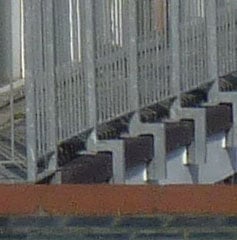 | 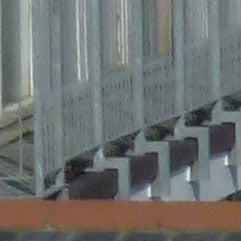 | 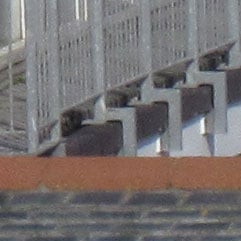 | ||
48.8mm (271mm) f4, 80 ISO | 47.5mm (264mm) f4.5, 100 ISO | 56.1mm (313mm) f5, 80 ISO | ||
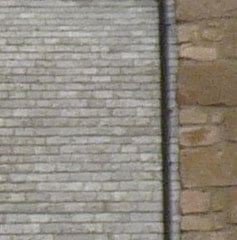 |  |  | ||
48.8mm (271mm) f4, 80 ISO | 47.5mm (264mm) f4.5, 100 ISO | 56.1mm (313mm) f5, 80 ISO | ||
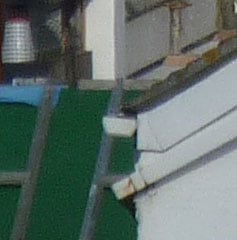 | 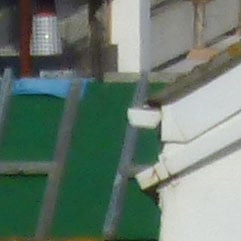 | 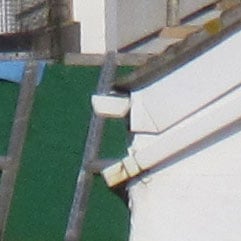 | ||
48.8mm (271mm) f4, 80 ISO | 47.5mm (264mm) f4.5, 100 ISO | 56.1mm (313mm) f5, 80 ISO | ||
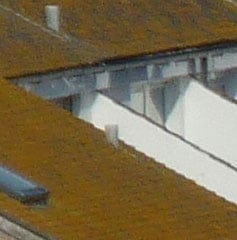 | 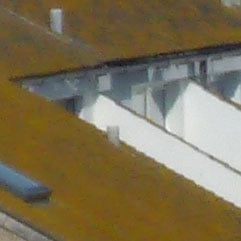 | 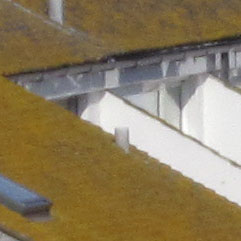 | ||
48.8mm (271mm) f4, 80 ISO | 47.5mm (264mm) f4.5, 100 ISO | 56.1mm (313mm) f5, 80 ISO |
Panasonic Lumix FZ45 / FZ40 results : Real-life resolution / Sharpness mid-range / Sharpness tele / High ISO Noise / Vs FZ38 / FZ35
To compare real-life performance mid-way through their focal ranges, we shot this scene with the Panasonic Lumix FZ 45 / FZ40, the Lumix FZ100 and the Canon PowerShot SX30 IS within a few moments of each other using their best quality JPEG settings. The lenses on each camera were set to approximately the same field of view to evaluate their performance around the middle of their zoom range. We opted for an equivalent focal length of around 300mm on each model. All three cameras were set to Program mode at the lowest available ISO sensitivity – 80 ISO on the Lumix FZ45 / FZ40 and PowerShot SX30 IS, and 100 ISO on the Lumix FZ100. The above image was taken with the Lumix FZ45 / FZ40 in Program mode. The lens was set to 48.8 mm (271mm equivalent) and the metering selected an exposure of 1/1300th of a second at f4 with an ISO setting of 80. The original 4320 × 3240 pixel image had a file size of 5MB. In a reversal of the situation with the wide angle crops, the Lumix FZ45 / FZ40 turns in a sharper, more contrasty result than the PowerShot SX30 IS. But if you look closely at the crops there is a granular, noisy quality to them and it doesn’t look as if the Lumix FZ45 / FZ40 lens is actually resolving any more detail than that of the PowerShot SX30 IS; at this focla length, the Canon has also lost the colour fringing problems that beset it at the wide angle setting. Despite the fact that it was shot at the lowest ISO sensitivity setting of 80, the crops from the Lumix FZ45 / FZ40 actually look like they are from a higher ISO image. But let’s not be too critical, these crops stand up on their own merits and in the middle of the zoom range, where it’s likely to get plenty of use, the Lumix FZ45 / FZ40 bears close comparison with the more expensive PowerShot SX30 IS. The crops from the Lumix FZ100 share the granular look of those from the Lumix FZ45 / FZ40, but they lack the edge contrast and look very soft in comparison to those of both its stablemate and the PowerShot SX30 IS. Take a look at the detail in the vertical bars of the balcony rail in the first crop, the brickwork in the second and the roof tiles in the fourth and final crop, in each of them the Lumix FZ100 comes last in terms of the amount of detail you can make out. If you haven’t done so already, be sure to take a look at our wide-angle resolution and telephoto resolution test pages before seeing how they compare at higher sensitivities in our High ISO Noise results. |
Panasonic Lumix FZ45 / FZ40 vs Lumix FZ100 vs Canon PowerShot SX30 IS Real-life resolution (telephoto)
Panasonic Lumix FZ45 / FZ40 results : Real-life resolution / Sharpness mid-range / Sharpness tele / High ISO Noise / Vs FZ38 / FZ35
Panasonic Lumix FZ45 / FZ40 | Panasonic Lumix FZ100 | Canon PowerShot SX30 IS | ||
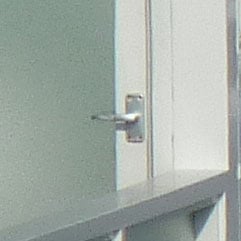 | 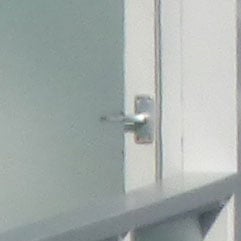 | 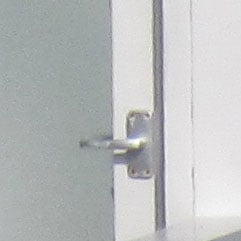 | ||
108mm (600mm) f5.2, 80 ISO | 108mm (600mm) f5.2, 100 ISO | 150.5mm (840mm) f5.8, 80 ISO | ||
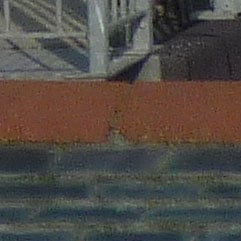 |  | 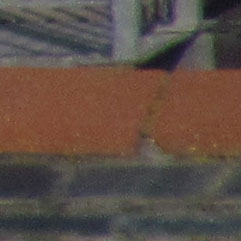 | ||
108mm (600mm) f5.2, 80 ISO | 108mm (600mm) f5.2, 100 ISO | 150.5mm (840mm) f5.8, 80 ISO | ||
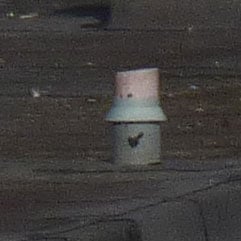 | 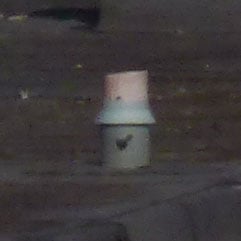 | 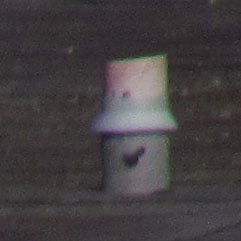 | ||
108mm (600mm) f5.2, 80 ISO | 108mm (600mm) f5.2, 100 ISO | 150.5mm (840mm) f5.8, 80 ISO |
Panasonic Lumix FZ45 / FZ40 results : Real-life resolution / Sharpness mid-range / Sharpness tele / High ISO Noise / Vs FZ38 / FZ35
To compare real-life performance with the lenses zoomed all the way in, we shot this scene with the Panasonic Lumix FZ45 / FZ40, the Lumix FZ100 and the Canon PowerShot SX30 IS within a few moments of each other using their best quality JPEG settings. The lenses on each camera were set to the maximum telephoto end of their zoom range. For the Lumix FZ45 / FZ40 and Lumix FZ100 this is an equivalent of 600m and for the Canon Powershot SX30 IS it’s 840mm. All three cameras were set to Program mode at the lowest available ISO sensitivity – 80 ISO on the Lumix FZ45 / FZ40 and the PowerShot SX30 IS and 100 ISO on the Lumix FZ100. The above image was taken with the Lumix FZ45 / FZ40 in Program mode. The lens was set to 108 mm (600mm equivalent) and the metering selected an exposure of 1/800th of a second at f5.2 with an ISO setting of 80. The original 4320 × 3240 pixel image had a file size of 5.25MB. At the maximum telephoto end of its reach, 600mm equivalent, the Panasonic Limix FZ45 / FZ40 produces mixed results. If you already own an FZ45 / FZ40 a glance at the first crop from the centre of the frame will leave you felling very pleased with yourself, and so it should. The door handle is pin sharp and you can see every detail right down to the screws. The other two crops from closer to the edge of the frame are less impressive. The granularity evident in the mid-range crops is present here to an even greater degree. In the second crop it’s hard to miss, but is particularly bad in the gaps between the roof tiles and on the ridge tiles. By comparison the results for the PowerShot SX30 IS are equally equivocal. The colour fringing that showed up on the wide angle crops and disappeared in the mid-range ones is now back again, and it too suffers from progressive degradation towards the edges of the frame. Overall though, the quality of the crops from the PowerShot SX30IS at the 840mm telephoto end of the zoom range is very good indeed and given the extra magnification factor are more than a match for those from the Lumix FZ45 / FZ40 The Lumix FZ100 results at this end of the zoom range largely bear out what we’ve seen elsewhere. The Lumix FZ100 image quality isn’t poor, far from it, but by comparison with the PowerShot SX30 IS the test image is soft and much of the fine detail is lost. This is most clearly evident in the last of the four crops below. If you haven’t done so already, be sure to take a look at our wide-angle resolution and mid range resolution test pages before seeing how they compare at higher sensitivities in our High ISO Noise results. |
Panasonic Lumix FZ38 / FZ35 vs Lumix FZ45 / FZ40 vs Lumix FZ100 Real-life resolution RAW (wide)
Panasonic Lumix FZ45 / FZ40 results : Real-life resolution / Sharpness mid-range / Sharpness tele / High ISO Noise / Vs FZ38 / FZ35
Panasonic Lumix FZ38 / FZ35 (RAW) | Panasonic Lumix FZ45 / FZ40 | Panasonic Lumix FZ100 | ||
 |  |  | ||
f4, 80 ISO | f4, 80 ISO | f4, 100 ISO | ||
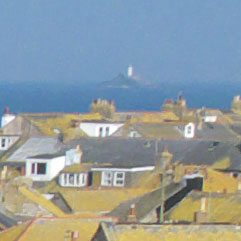 |  |  | ||
f4, 80 ISO | f4, 80 ISO | f4, 100 ISO | ||
 |  |  | ||
f4, 80 ISO | f4, 80 ISO | f4, 100 ISO | ||
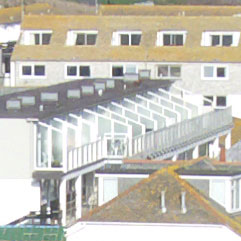 |  |  | ||
f4, 80 ISO | f4, 80 ISO | f4, 100 ISO |
Panasonic Lumix FZ45 / FZ40 results : Real-life resolution / Sharpness mid-range / Sharpness tele / High ISO Noise / Vs FZ38 / FZ35
We shot the scene opposite with the Panasonic Lumix FZ38 / FZ35, Lumix FZ45 / FZ40 and the Lumix FZ100 in RAW+JPEG mode so that we could compare images produced from each camera using the RAW data. The lenses on each camera were set to approximately the same field of view. As all three cameras have closely matched maximum wide-angle focal lengths – 27mm equiv for the Lumix FZ38 / FZ35 and 25mm equiv for the Lumix FZ45 / FZ40 and FZ100 we used these settings for our wide-angle quality comparisons. All three cameras were set to their lowest available ISO sensitivity – 80 ISO on the Lumix FZ38 / FZ35 and FZ45 / FZ40, and 100 ISO on the Lumix FZ100. The RAW image files were processed using the supplied SilkyPIX Developer Studio 3.1 SE. By default, the Unsharp Mask is set to zero in SilkyPIX, which unsurprisingly delivers a very soft result, so here we’ve increased the amount to 100 in order to accentuate fine details. For a level playing field, not to mention to avoid diffraction, we set the aperture to f4 on all three models using Aperture Priority; note the earlier FZ38 / FZ35 has a tendency to select f5.6 in program or Auto modes, given a bright scene, and as we saw in our review of that model, this will soften the result due to diffraction. The image above was taken with the Lumix FZ38 / FZ35 with the lens at 4.8mm (27mm equivalent), where the metering selected an exposure of 1/500th of a second at f4 using an ISO setting of 80. The original RAW file was 14 MB from which SilkyPIX produced a 5MB JPEG. We’ve seen test crops from the Lumix FZ38 / FZ35 before, of course, in our full review, but what’s interesting here is to compare it with images shot from the the two newer cameras, the FZ45 / FZ40 and the FZ100, particularly in light of reports that the Image quality of the FZ45 / FZ40 and FZ100 are not up to that of their predecessor. We’ve looked long and hard at the 100 percent crops below and it really is too close to call for the FZ38 / FZ35 versus the FZ45 / FZ40, at least at 80 ISO. Doubtless there will, and have been, those who say the image quality of the FZ38 / FZ35 is better than that of the FZ45 / FZ40, but we’d put them neck and neck here at their lowest sensitivity. Look closely and the FZ45 / FZ40 looks to be marginally better in terms of detail on the lighthouse crop and the third crop from the frame edge with the roof tiles. But in the first and last crops the FZ38 / FZ35 looks slightly sharper and more detailed. The earlier model also has fractionally fewer noise speckles in areas of flat colour like the blue sky, but again this is serious pixel-peeping. Don’t forget that with these comparisons we’re also not comparing shots from the same sized sensor shot at exactly the same focal length. The FZ38 / FZ35’s 12 Megapixel sensor produces a 4000 x 3000 pixel image whereas images from the 14 Megapixel FZ45 / FZ40 measure 4320 x 3240 pixels. And the FZ38 / FZ35’s wide angle is 27mm compared with the FZ45 / FZ40’s 25mm. These differences effectively cancel each other out on this page, which is why the crops show the same area. On balance, it seems fair to conclude Panasonic has delivered a camera with a longer lens and slightly higher resolution that’s capable of producing images every bit as good as those of its predecessor – albeit not actually superior, and again we’ve only tested here at the lowest sensitivity. As for the Lumix FZ100 though, that’s a different story. As you can see on our first results page, its in-camera JPEGs suffer from noticeable smearing which greatly reduces fine detail. On this page though, the RAW files have revealed what’s happening underneath: a reasonable degree of detail is recorded, but with higher visible noise speckles. Clearly Panasonic has attempted to mask these higher noise levels on in-camera JPEGs with noise reduction, but the result is smearing. By tweaking the in-camera noise reduction, or processing RAW files, it’s possible to retrieve much more detail from the FZ100, albeit at the cost of higher visible noise levels. That much is clear from the crops below. But what’s also clear is the older FZ38 / FZ35, like its successor, still out-performs the FZ100 in terms of detail and noise levels whether shooting JPEG or RAW. In our full review of the FZ100 we’ll examine these quality issues in more detail and look at ways of squeezing the best possible results from the camera’s 14 Megapixel CMOS sensor. Now head over to our Panasonic Lumix FZ45 / FZ40 gallery to see some more real-life shots in a variety of conditions. |
Panasonic Lumix FZ45 / FZ40 vs Lumix FZ100 vs Canon PowerShot SX30 IS High ISO Noise
Panasonic Lumix FZ45 / FZ40 results : Real-life resolution / Sharpness mid-range / Sharpness tele / High ISO Noise / Vs FZ38 / FZ35
Panasonic Lumix FZ45 / FZ40 results : Real-life resolution / Sharpness mid-range / Sharpness tele / High ISO Noise / Vs FZ38 / FZ35
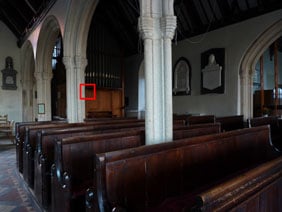 |
|
To compare noise levels under real-life conditions we shot this scene with the Panasonic Lumix FZ45 / FZ40, the Lumix FZ100 and the Canon PowerShot SX30 IS.
The lenses on all three cameras were set to approximate the same field of view and ISO was manually set.
The above shot was taken with the the Lumix FZ45 / FZ40 in Program mode with the lens at a wide angle setting of 4.5mm (25mm). The ISO sensitivity was set to 80 and the exposure was one second at f2.8. The crops are taken from the area marked with the red square and presented below at 100%.
The Lumix FZ45 / FZ40 makes a very promising start. At 80 and 100 ISO the crops look clean, noise free and show good detail. Arguably, the detail in the stone column on the left of the crop is a little on the soft side, but there’s no obvious evidence of noise and overall this is a result that anyone would be happy with.
Moving on up the range to 200 ISO we start to see some evidence of noise, but you have to look closely. There some clumping of pixel values in the wood panelling and the edge of the stone column isn’t as crisp and well-defined as in the 80 and 100 ISO crops. There’s not much to worry about at this level, though. Unless you were looking closely at a full-sized print you’d never notice it and it certainly wouldn’t make you think twice about using 200 ISO for situations when the light is dropping that little bit.
At 400 ISO the loss of detail and pixel clumping gets progressively worse and is now at the stage where you don’t have to be looking for it to see it. If you were viewing this 400 ISO shot full screen on a 15inch notebook, you’d be able to tell it was a high ISO shot. Having said that, the noise isn’t overwhelming and the result is very accepatble for the middle of the Lumix FZ45 / FZ40’s sensitivity range.
From 800 ISO and up the noise is pretty intrusive, but that’s what you’d expect. Even at these higher ISO sensitivities, and, in fact, throughout the range Panasonic has done a good job in maintaining the always difficult balance beween noise supression and loss of real image detail.
As with our outdoor tests, the Lumix FZ100 crops are all marred by an overwhelming softness that smears away all the fine detail. Take a look at the vertical grooves in the panelling of the 100 ISO crop, they’re indistinct at the top and blur away into nothing at the bottom. At 400 ISO the grooves have disappeard into a clumpy regularity – though they are still clearly visible in the Lumix FZ45 / FZ40 and PowerShot SX30 IS crops.
The results from the Canon PowerShot SX30 IS stand much closer in comparison to the Lumix FZ45 / FZ40. At 80 and 100 ISO there’s very little to tell them apart. The fringing on the PowerShot SX30 IS crops doesn’t do anything for the edge definition, but despite that we think the PowerShot SX30 IS is doing a slightly better job of retaining detail. The detail in the wood panelling in this crop does look granier than in the Lumix FZ45 / FZ40 crops, however. Through the middle of the ISO range there’s still very little in it, though here the difference between Panasonic’s and Canon’s approach to noise supression becomes clearer. The Lumix FZ45 / FZ40 crops generally look smoother than PowerShot SX30 IS ones which show more detail, but more noise as well.
One thing worth noting is that all of these cameras produce a better result in their lower resolution low light scene modes than they do at the full resolution 1600 ISO sensitivity, something worth bearing in mind if image size isn’t a big consideration. Here, the Lumix models have a slight advantage, producing a 3 Megapixel image measuring 2048 × 1536 pixels against a 2 Megapixel 1600 × 1200 image from the PowerShot SX30 IS. Now head over to our Panasonic Lumix FZ45 / FZ40 gallery to see some more real-life shots in a variety of conditions.
Panasonic Lumix FZ45 / FZ40 | Panasonic Lumix FZ100 | Canon PowerShot SX30 IS | ||
 |  | |||
80 ISO | 80 ISO Not available | 80 ISO | ||
 |  |  | ||
100 ISO | 100 ISO | 100 ISO | ||
 | 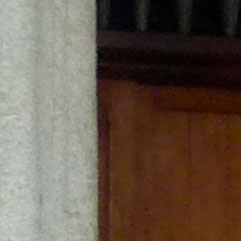 |  | ||
200 ISO | 200 ISO | 200 ISO | ||
 |  |  | ||
400 ISO | 400 ISO | 400 ISO | ||
 | 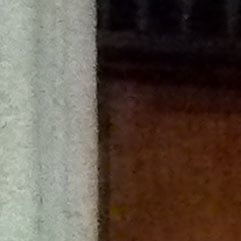 |  | ||
800 ISO | 800 ISO | 800 ISO | ||
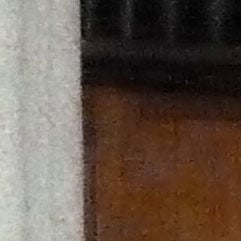 | 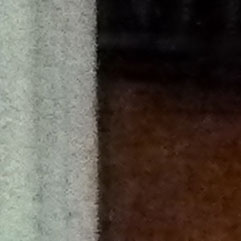 | 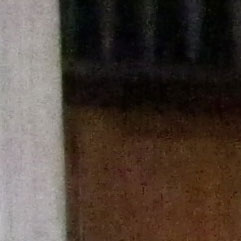 | ||
1600 ISO | 1600 ISO | 1600 ISO | ||
 | 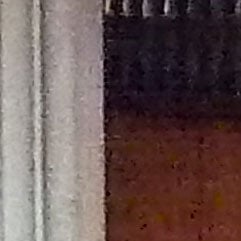 |  | ||
3200 ISO (High Sens scene mode) | 3200 ISO (High Sens scene mode) | 2500 ISO (Low Light scene mode) |
